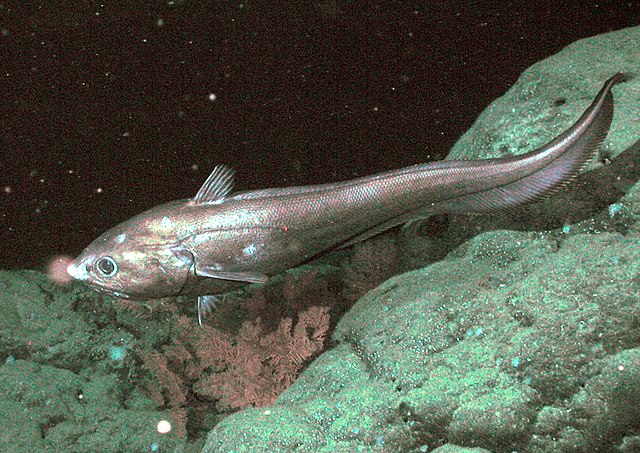
How do deep sea creatures see? They don’t see color, they have very large eyes, they use other senses, or they produce their own light.
Light doesn’t penetrate very far into the ocean. It starts to get absorbed about 200 meters down and by about 1,000 m it has pretty much all gone. Because of that, the majority of sea life is found in the top two layers of the sea, called the epipelagic zone (down to 200 m) and the mesopelagic zone (down to 1000 m). Animals in the epipelagic zone rely heavily on light and vision. The mesopelagic zone is known as the twilight zone because the light is fading and as we go deeper into this zone, the creatures rely on light less than those at the surface. and less. 90% of all the world’s fish live in this zone. The next zone down is called the bathypelagic zone and it stretches from 1,000 to 4,000 m. There is no light here.
That means the creatures that live at the bottom of the oceans don’t have any light. Sea creatures have been found down to depths of almost 9,000 meters. There is a snailfish that has large teeth and no scales which has been found at this depth. There are probably other sea creatures at great depths as well, but scientists have not been down there very often. The saying that we know more about the surface of the moon than we do about the bottom of the oceans is very true. Creatures at these depths have to cope with more than just a lack of light. For one, it is very cold. The temperature will drop to 0, or sometimes lower. The water doesn’t freeze because of the salinity, but the animals have to survive. There is also the pressure to cope with. Deep sea creatures have to cope with pressures that are 600 to 1,000 times greater than they are on the surface. Another reason why we haven’t been able to observe so many deep sea creatures is because we cannot bring them to the surface. They have adapted to live under great pressure and if we bring them up, they will explode.
So, how do creatures at great depth see with no light? The first thing we need to think about is the bottom of the ocean is not actually pitch black. There is no light coming down from the surface, but that doesn’t mean there isn’t any light. Many of the creatures that live in the depths are able to produce their own light. They are bioluminescent. There are two ways that fish can do this. The first way is through a reaction between a protein called luciferin and an enzyme called luciferase. When they react, a light photon is produced. The second way is through hosting a bacteria that can produce photons. Fish glow to communicate with each other or to hunt. The seabed itself also glows. There are a lot of deep vent systems on the ocean floor and they produce a very faint glow that would be far too dim for us to see.
The first thing they do is to only see in shades of grey. We see color through the cone cells in our eyes. We have cones for red, green, and blue light. We also have rods that we use to see at night. They cannot detect color, but they are far more sensitive to light. That is why you only see in black and white in the dark. Deepsea creatures have far more rods than we do so that they can detect even the faintest lights. They can detect the seabed and the other creatures that glow. They increase the amount they can see by having very large eyes. Larger eyes means more space for rods, which means they can detect more light. Although, I say they cannot see color, but recent evidence suggests that they may be able to see some form of color, or something that resembles color. We only have the one type of rod that detects light, but many deep fish have different types of rods of different lengths. Some of the rods are stacked on top of other rods to give them even more sensitivity to light. There is a theory that the different types of rods can detect different wavelengths of light, which is, in effect, seeing color. There is no way of testing this theory, though.
The last way that they see is to use their other senses. Fish have a very strong sense of smell. They can detect food from a long way away. If an animal dies on the surface, such as a whale, and it sinks to the bottom, thousands of fish and deep sea creatures are able to smell it and they gather very rapidly. Fish are also able to hear very well. Water carries sound much further than in the air, so they can hear the motion of prey or predators. And some fish are even able to detect the electric field that other fish give off. So, deep sea creatures don’t necessarily need eyes, although they can see very well with what little light there is. And this is what I learned today.
Image By NOAA/MBARI – http://www.mbnms-simon.org/other/photos/photo_info.php?photoID=417, Public Domain, https://commons.wikimedia.org/w/index.php?curid=1935687
Sources
https://www.science.org/content/article/deep-dark-ocean-fish-have-evolved-superpowered-vision
https://www.montereybayaquarium.org/stories/deep-sea-animal-adaptations
https://manoa.hawaii.edu/exploringourfluidearth/physical/ocean-depths/light-ocean
https://ocean.si.edu/ecosystems/deep-sea/deep-sea
https://www.quora.com/Why-do-the-fish-deep-down-in-the-oceans-have-eyes-while-its-completely-dark
https://oceanexplorer.noaa.gov/explorations/19biolum/background/vision/vision.html
https://qbi.uq.edu.au/article/2021/12/deep-sea-fish-eyes-are-not-freaky-accident
https://blogs.scientificamerican.com/artful-amoeba/80-percent-of-open-ocean-fish-make-light/
https://dnr.illinois.gov/content/dam/soi/en/web/dnr/oi/documents/july08canfishsmell.pdf
